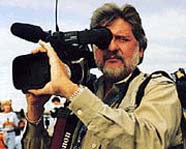|
|
Letter
from |
Welcome
to the AUGUST 2001 edition of The Digital Journalist.
"Woe is Me!"
is the title of Amy Bower's column this month. She writes about the collapsing
market for photojournalists. Unwittingly, on our part, this theme is a
common thread throughout this month's issue.
In our editorial,
we acknowledge that photojournalism is in a recession today. A weak economy
combined with consolidations and bottom-lining—not to mention technological
changes—have impacted on photographers' lives. In some ways, the
Great Depression doesn't look quite so bad by comparison, as far as photojournalists
are concerned. At least during that period, magazines like Fortune and
Life were created, giving birth to modern photojournalism.
Our columnist Jim Colburn rants about how the takeover of photo agencies
by megacorporations has killed the market for photography.
Even our normally unflappable contributing editor Peter Howe is caught
up in the dismembering of the profession and issues a call, "To the
Barricades, Comrades!"
We present two multimedia features this month. The first is a wonderful
retrospective by Magnum photographer Paul Fusco on pictures taken through
the window of Robert F. Kennedy's funeral train. It bore the body of the
slain candidate from New York back to Washington, for burial, in the summer
of 1968.
In the second, we take a peaceful summer break and show a collection of
photographs of the New England seacoast community from Nubar Alexanian's
soon-to-be published book, Gloucester Photographs.
In April of 1976, I was invited to photograph on the set of "Apocalypse
Now," which was just starting to film in the jungles of Luzon in
the Philippines. I had no idea what I was getting into. I was entering
a world where the reality and the art of creating a movie about the Vietnam
experience was about to lead cast and crew into a world of delusion and
madness. This month, a new version of this movie classic opens in theaters
around the country with nearly an hour of new footage. I take you behind
the scenes in my War Stories and Legends article "Apocalypse Finally."
Bill Pierce, in his "Nuts and Bolts" column, muses about the
differences between analog and digital in both still and motion photography.
The Digital Filmmaker's editor Roger Richards takes the new Nikon D1X
on assignment and gives us his Camera Corner review.
Videosmith's Martha Smith continues her series on creating professional
quality sound, by discussing "Critical Listening."
We hope you enjoy this issue, and have a great August.
Dirck Halstead
---------------------------------------------------------------------------------------------------------
ASSIGNMENT SHEET.
The August edition
of Assignment Sheet has a visual smorgasbord as well as some compelling
journals that will challenge the way you think about news photography.
There are some of the usual contributors to the page as well as some new
talents.
How many of us get to cover rodeos? Baseball, football, basketball, soccer,
yes. But, in some parts of the country, rodeo is big league sport. "IT'S
RODEO TIME" by Les Stukenberg, Staff Photographer for The Daily
Courier in Prescott, AZ tells us what life is like in the fast paced
rodeo arena.
What do you do when your photo offends the head of your town's largest
employer? Find out what Mark Hertzberg did in his journal, "MY NAME
IS MUD." Mark is Director of Photography at the Racine (WI) Journal
Times. In his journal, "SEEKING CALM IN THE EYE OF THE STORM,"
Greg Smith an Independent Photographer and Storyteller from Bluffton,
S.C., tells us about dealing with man made as well as natural storms while
trying to earn a living as a photographer and a storyteller.
The recent Federal execution of Timothy McVeigh created a furor of news
coverage and editorial comment. What was it like for a photographer from
a medium sized paper who wound up in the center of the action with all
of the
networks, agencies and major papers and magazines?
"I now realize why I work at a medium-size newspaper in the Midwest
(my fourth newspaper job in my eight years in the profession) where the
photographers don't travel in packs and our subjects aren't so media savvy.
I feel like our pictures turn out to be more honest when we're notbeing
put through the hoops by the media handlers and especially our subjects."
"EXECUTION," by Denny Simmons, Staff Photographer for the Evansville
Courier and Press takes you there through his eyes and his lens.
After years of complaining about working for news side and covering "head
shots and real estate," Dick Kraus, Newsday Staff Photographer,
writes "WORKING FOR THE FEATURES DESK," and of the opportunities
to do some.
Through the eyes of youth, we get a different perspective on the state
of news photography. Joe Jaszewski writes about his internship at the
Houston Chronicle.
"At a newspaper this large, and probably at many which are much
smaller,there isn't much hand-holding. They throw you in with the sharks
at the beginning and it is sink or swim."
Read his thoughts in "FOURTH OF JULY" by Joe Jaszewski, Photo
Intern Houston (TX) Chronicle.
"I think we all need to get a life, as the saying goes. We need
to go out and play ball with our kids, take a walk, read a book, talk
to our spouses. What we really need to do is to stop being captive for
awhile, and turn off the computer. (Funny, I think I've heard the same
thing about TV). The news will still be there and chances are, hearing
it or seeing it five or fifty minutes from now won't radically change
our lives. The story is in the quality of the telling, not necessarily
who gets there first."
That makes a lot of sense. Susan Markisz, a freelancer who works with
the N.Y. Times and the United Nations has more to say about this
in her well thought-out journal, "WHAT'S THE RUSH?"
